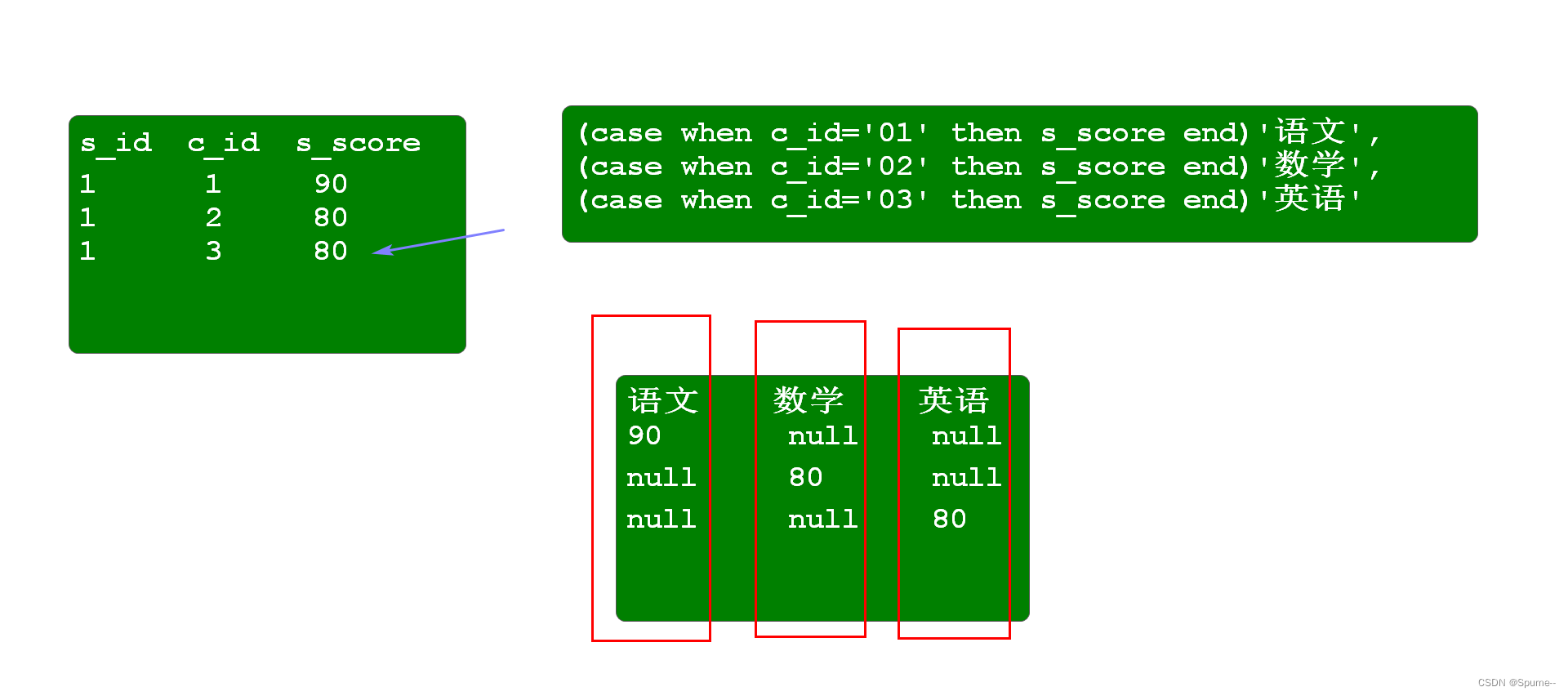数据结构和算法 III
面试题
19道题目:
1、查询"语文"课程比"数学"课程成绩高的学生的性别及课程分数
三表联查:
select s.*,sc1.s_score'语文分数',sc2.s_score'数学分数' from score sc1 join score sc2 join student s on sc1.s_id=sc2.s_id and sc1.s_id=s.s_id where sc1.c_id=(select c_id from course where c_name='语文') and
sc2.c_id=(select c_id from course where c_name='数学') and sc1.s_score>sc2.s_score
2、查询"语文"课程比"数学"课程成绩低的学生的性别及课程分数
3、查询平均成绩大于等于60分的同学的学生编号和学生姓名和平均成绩
4、查询平均成绩小于60分的同学的学生编号和学生姓名和平均成绩(包括有成绩的和无成绩的)
求平均分不能使用avg,应该使用总分/总课程数
select s.s_id,s_name,ifnull(sum(s_score),0)/(select count(*) from course) av from student s left join score sc on s.s_id=sc.s_id group by s.s_id having av<60
5、查询所有同学的学生编号、学生姓名、选课总数、所有课程的总成绩
select s.s_id,s_name,count(c_id)'选课总数',sum(s_score)'总成绩' from student s left join score sc on s.s_id=sc.s_id group by s.s_id
6、查询"王"姓老师的数量
select count(*) from teacher where t_name like '王%'
7、查询学过"张三"老师授课的同学的信息
select s.* from teacher t join course c join score sc join student s on t.t_id=c.t_id and c.c_id=sc.c_id and sc.s_id=s.s_id where t_name='张三'
8、查询学过编号为"01"并且也学过编号为"02"的课程的同学的信息
select s.*,sc1.s_score'01',sc2.s_score'02' from student s join score sc1 join score sc2 on sc1.s_id=sc2.s_id and sc1.s_id=s.s_id where sc1.c_id='01' and sc2.c_id='02'
9、按平均成绩从高到低显示所有学生的所有课程的成绩以及平均成绩
s_id, 语文 数学 英语 平均成绩
select s.s_id,s_name,sum(s_score)/(select count(*) from course) av,
max(case when c_id='01' then s_score end)'语文',
max(case when c_id='02' then s_score end)'数学',
max(case when c_id='03' then s_score end)'英语'
from student s left join score sc on s.s_id=sc.s_id group by s.s_id order by av desc
分组过程中,对遍历到的每条数据,都会进行三次case when 判断,则一个学生的三门成绩最终以三行存在,而各门课程的成绩应为三行中的最大值,所以应该使用max

10、查询各科成绩最高分、最低分和平均分:以如下形式显示:课程ID,课程name,最高分,最低分,平均分,及格率,中等率,优良率,优秀率 (及格为>=60,中等为:70-80,优良为:80-90,优秀为:>=90)
select c.c_id,c_name,max(s_score)'最高分',min(s_score)'最低分',avg(s_score),
concat(round(sum(case when s_score>=90 then 1 else 0 end)/count(s_id)*100,2),'%') '优秀率',
concat(round(sum(case when s_score>=80 and s_score<90 then 1 else 0 end)/count(s_id)*100,2),'%') '优良率',
concat(round(sum(case when s_score>=70 and s_score<80 then 1 else 0 end)/count(s_id)*100,2),'%') '中等率',
concat(round(sum(case when s_score>=60 then 1 else 0 end)/count(s_id)*100,2),'%') '及格率'
from course c left join score sc on c.c_id=sc.c_id group by c.c_id
concat('','%') -- 拼接
保留小数函数:
round(x,d) -- 四舍五入,d表示保留几位 x表示小数
truncate(x,d) -- 截取几位小数 x:小数 d:截取几位小数
11、查询每门科目成绩都在60分及以上的学生id,姓名,成绩
1. max(case when)
select s.s_id,s_name,
max(case when c_id=(select c_id from course where c_name='语文') then s_score end) chinese,
max(case when c_id=(select c_id from course where c_name='数学') then s_score end) math,
max(case when c_id=(select c_id from course where c_name='英语') then s_score end)english
from student s join score sc on s.s_id=sc.s_id group by s.s_id having chinese>=60 and math>=60 and english>=60
或:
将成绩表视为3份,分别作为语文成绩表,且分数>=60 数学成绩表,且分数>=60 英语成绩表 且分数>=60
三张成绩表自连接,最后和学生表连接
select s.s_id,s_name,sc1.s_score'语文',sc2.s_score'数学',sc3.s_score'英语'
from student s
join score sc1 join score sc2 join score sc3
on sc1.s_id=sc2.s_id and sc2.s_id=sc3.s_id and sc1.s_id=s.s_id
where sc1.c_id='01' and sc1.s_score>=60 and sc2.c_id='02' and sc2.s_score>=60 and sc3.c_id='03' and sc3.s_score>=60
12、查询至少有一门科目成绩在90分以上的学生id,姓名,成绩
select s.s_id,s_name,
max(case when c_id='01' then s_score end)'语文',
max(case when c_id='02' then s_score end)'数学',
max(case when c_id='03' then s_score end)'英语'
from student s join score sc on s.s_id=sc.s_id group by sc.s_id having max(s_score)>90
13、查询所有科目成绩总和在240分及以上的学生id,姓名,和成绩总和,降序排列
select s.s_id,s_name,sum(s_score) sum from student s join score sc on s.s_id=sc.s_id group by s.s_id having sum>=240 order by sum desc
14、查询每个科目成绩最高的学生的学生id,姓名,写在一个表里
create table tname as select....
1. 查询每门科目的最高分
2. 根据科目id和对应的最高分到成绩表中查询对应的学生id
3. 根据学生id到学生表查询学生数据
create table new_table as
select s.s_id,s_name,tmp.c_id,tmp.max from score sc join student s join (select c_id,max(s_score)max from score group by c_id)tmp on sc.c_id=tmp.c_id and sc.s_score=tmp.max and sc.s_id=s.s_id
15、查询每个科目成绩最低的学生的学生id,姓名
16、查询目前没有安排课程的老师姓名
思路:查询老师教授的课程,筛选课程id为null值的数据
select t_name from teacher t left join course c on t.t_id=c.t_id where c_id is null
17、将之前老师表的英文名字转化为大写
转换大小写函数:
upper(col) lower(col)
update teacher set t_name=upper(t_name)
18、查询学生表中重复的姓名
姓名重复的判断:判断姓名出现的次数,若大于1,则重复
select s_name from student group by s_name having count(s_id)>1
19、统计各科成绩各分数段人数:课程编号,课程名称,[100-85],[85-70],[70-60],[0-60]及所占百分比
select c.c_id,c_name,count(s_id),
sum(case when s_score>=85 and s_score<=100 then 1 else 0 end)'[100-85]',
sum(case when s_score>=70 and s_score<85 then 1 else 0 end)'[85-70]',
sum(case when s_score>=60 and s_score<70 then 1 else 0 end)'[70-60]',
sum(case when s_score<60 then 1 else 0 end)'[0-60]',
concat(round(sum(case when s_score>=85 and s_score<=100 then 1 else 0 end)/count(s_id)*100,0),'%') '[100-85]百分比',
concat(round(sum(case when s_score>=70 and s_score<85 then 1 else 0 end)/count(s_id)*100,0),'%') '[85-70]百分比',
concat(round(sum(case when s_score>=60 and s_score<70 then 1 else 0 end)/count(s_id)*100,0),'%') '[70-60]百分比',
concat(round(sum(case when s_score<60 then 1 else 0 end)/count(s_id)*100,0),'%') '[0-60]百分比'
from course c left join score sc on c.c_id=sc.c_id group by c.c_id
单例 – 笔试
- 题目:请写出lazy单例
- 单例的分类:
- 懒汉式单例
- 饿汉式单例
懒汉式单例:
-
单例: 某个类在整个应用程序中只有一个实例
class T{ 多例: 多个实例 private T(){ } private static T t; public static T getInstance(){ //判断当前类的实例是否已经存在,若存在,直接返回;若不存在,则创建实例并返回 if(t==null) t = new T(); return t; } } class Test: main: T t = T.getInstance(); 若T类的实例在整个应用程序中只能有一个,则为单例 -
如何实现懒汉式单例
核心点: 1. 构造方法私有化 2. 提供公有的static方法用于向外部提供实例 方法内部: 判断引用是否为null,为null,创建实例并返回;不为null,直接返回实例 3. 在成员变量位置声明私有的static的引用(只声明不初始化) -- 懒汉式体现 4. 多线程并发访问存在线程安全问题,将方法变为同步的 public class LazySingleton { private LazySingleton(){ } private static LazySingleton lazySingleton; public synchronized static LazySingleton getInstance(){ if (lazySingleton==null) lazySingleton = new LazySingleton(); return lazySingleton; } }饿汉式单例
public class HungrySingleton{ private HungrySingleton(){ } private static HungrySingleton singleton = new HungrySingleton(); public static HungrySingleton getInstance(){ return singleton; } }